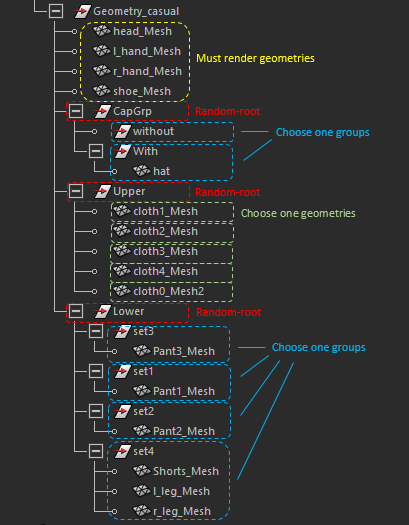...
General
We can easily re- arrange the structure of these the geometries in Geometry_<agent type> group for achieving randomization.There are 3 rules for making the geometries random:
With the randomize the geometries, we can make different agent looks unique in render time.
Instructions
Random Rules
- The geometries directly under the Geometry_<agent type> will be always rendered .And if there are several sub groups, and these sub groups are children of a root group, and this root group is directly under the Geometry_<agent type>. We (in yellow bound)
- The group nodes directly under Geometry_<agent type>, we call them random-root (red bounds), one of the geometries (green bounds) in random-root will be chosen and rendered..
- The group nodes directly under Geometry_<agent type>, we call them random-root (red bounds), if there are deeper sub groups/meshes (blue bounds) in random-root, it won't random deepr groups anymore, render engine will choose all the geometries/groups in one of sub groups even there still have hierarchy in sub groupthese groups (blue bounds) and render them. Notice, there may be no geometry in sub group .If the geometries under a child group of Geometry_<agent type>, one of these geometries will be rendered.
...
- (like the cap in below example)
Random rules example. One of the items in green bound will be selected.
...
1. The items in the first orange bound will obey rule 1
The system will choose one of the geometries from the green bound. For example, "head_Mesh2", "l_arm_Mesh", "l_shoe_Mesh", "r_arm_Mesh" and "r_shoe_Mesh" will be all selected.
2. The items in the second and third orange bound will obey rule 2
The system will choose one of the groups in green bound, and then fetch all the geometries out from that group. If that group doesn't have geometry, the system will not fetch anything, whereas if that group has further sub hierarchy, the system will fetch all the geometries from all sub hierarchy, for example, in "set1" will be chosen, and all the geometries in "set1" and sub hierarchy will be all selected.
3. The items in the fourth orange bound will obey rule 3
The system will choose one of the geometries in green bound. For example, the "shirt_Mesh1" will be selected.
...
Random Result
Notice the cap, pants and t-shirt geometries
...

